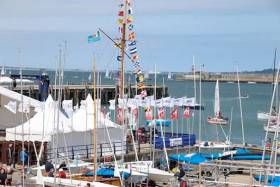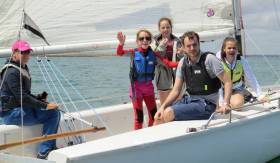Displaying items by tag: nyc
National Yacht Club Members Save On Clubhouse Price Rises
#NYC - National Yacht Club members will not have to pay a 10% increase in bar and catering prices brought in for the Dun Laoghaire waterfront clubhouse.
Instituted by the club committee after approval at last month’s AGM, the move has been made to maintain the club’s profit margin and sustain it into the future.
However, club members will not have to pay the increase if they use their membership cards, as a 10% bonus to match will be added to every top-up.
For more details on the new system, members are invited to contact Tim O’Brien at 01 280 5725 or [email protected], or email the honorary secretary at [email protected].
National Yacht Club Meeting For New Members Next Friday
#NYC - The National Yacht Cub will host a meeting for new and prospective members next Friday 27 April from 8pm in the main dining room.
The evening will be an opportunity to learn about the club’s various activities, meet its function head and explore sailing and other opportunities.
New members’ spouses, family and friends are welcome to learn about the club’s range of activities both on and off the water.
Club members are encouraged to attend with friends who are thinking about joining, while skippers looking for crew for 2019 are also welcome.
To register your attendance, contact Carmen McKeever at 01 280 5725 or email [email protected].
Also next Friday, the NYC Junior Section begins its weekly coaching sessions for Optimist sailors at minor, pre-racing and Start Racing levels.
The course will run for nine weeks, each Friday from 5pm to 7.30pm to coincide with Friday race training.
National Yacht Club To Host Sailing Awards Dinner Next Weekend
#NYC - Eleven accolades for outstanding achievement by its members will be presented at the National Yacht Club’s annual Sailing Awards Dinner next Saturday 24 February.
Among those to be recognised on the evening are Anne and Michael Madsen, who previously won the Township Cup in 2016 for an epic voyage to Norway.
Roberto Sastre will be presented the storied Boyne Regatta Cup for his offshore racing exploits, while Peter and Kerri Mulligan will receive the Muglins Cup for the most interesting family cruise of 2017.
To book your table at €35 per plate, call Tim or Louise at 01 280 5725, or email [email protected] or [email protected].
Clubhouse Events Calendar At National YC Till June 2018
#NYC - The National Yacht Club’s clubhouse dining events calendar for 2018 begins next Tuesday 9 January with the first ladies’ lunch, with guest speaker and clubhouse restaurant head chef Cormac Healy.
That’s followed later in the month by the first Preston Ball on Friday 19 January, and Peter Caviston’s Games Night on Saturday 20 January.
The popular wine suppers return twice monthly in January, February and March, with the first of these taking place on Wednesday 17h January.
A complete schedule of dining events at the Mitsubishi Motors Sailing Club of the Year 2018 running up to the Regatta dinner on Saturday 23 June is available from the NYC website HERE.
Make Your Reservation For NYC Junior Section’s ‘Big Reunion’ Party
#NYC - Reservations are going fast for the National Yacht Club Junior Section’s Golden Jubilee ‘Big Reunion’ party on Saturday 30 September, as previously reported on Afloat.ie.
The celebrations start at 7.30pm on the night and are open to all over 18 who have been involved in the Junior Section as sailors, parents, instructors or volunteers over the last 50 years.
The Big Reunion concludes the NYC’s series of events to mark the Junior Section’s five decades, which included July’s Pontoon 50 Splash and family flotilla, and May’s reunion dinner and family fun day.
This month's party — which also happens to take place on the final day of the DBSC season — will have an auction and a raffle with great prizes to raise funds for the club’s Jubilee Fireflies.
Tickets for the Big Reunion party must be purchased in advance from the NYC website HERE.
National YC Hosts End Of Season Race This Thursday
#NYC - The National Yacht Club’s End of Season fun race takes place this Thursday 7 September, open to all yachts and dinghies owned or helmed by a member of the NYC.
Entry is free, however the club will be running a fundraiser on the day for the RNLI and its vital lifeboat services.
The course will be shown on a noticeboard in the club prior to the race. Subject to suitable weather, it is planned to race from the harbour to a course in Dublin Bay and back.
Dinghies, Moths, Mermaids and Flying 15s will start at 6.30pm, followed by Ruffians, Shipmans and Crusier 3s at 6.35pm; 31.7s, Sigma 33s and Cruiser 5s at 6.40pm; and Cruisers 0-2, Lasers, SB20s and mixed sportboats at 6.45pm.
The start and finish will be within the harbour between the bandstand and an inflatable mark. Races will be started by using Rule 26 with the warning signal five minutes before the start.
Prizes will be awarded from 9.30pm in the club house for line honours, class winners and on handicap at the complete discretion of the NYC Sailing Committee.
Registration for the End of Season race is available on the NYC website HERE.
Reservations are also available for the NYC Junior Section’s Golden Jubilee ‘Big Reunion’ party from 7.30pm on Saturday 30 September.
The party is open to all over 18 who have been involved in the Junior Section as sailors, parents and instructors over the last 50 years.
Meanwhile, though the season might be ending, racing continues at the NYC — especially for 420 crews, as previously reported on Afloat.ie.
NYC’s Loghlen Rickard Sails Strong In Laser North Americans
#LaserRadial - National Yacht Club sailor Loghlen Rickard was a close second in the Laser Radial at this past weekend’s Leinsters in Rush.
It’s the latest strong result for the youth sailor who recently took his talents some 7,000km west for the Laser North American Championships in Vancouver, Canada.
Racing was held over for days of varied light to medium winds at the Royal Vancouver Yacht Club on English Bay from 21 June.
Loghlen started strong with a bullet in race one, and had eight top-five finishes in the 12-race event.
The NYC sailor and Fort Lauderdale’s Sophia Reineke came off the water after 12 races tied on points in first and second respectively.
But a controversial protest saw them both disqualified from the last race, resulting in Vancouver’s own two-time Olympian Luke Ramsay taking the top step of the podium and Loghlen slipping to sixth after discards.
Nevertheless, it was a remarkable showing from the Dun Laoghaire stalwart, who also recently competed at the Radial Youth Euros in Poland.
Last Sunday was a perfect sailing day – sun, wind, and lots of smiles as we celebrated 50 years of the Junior Sailing Section at the NYC. Commodore Ronan Beirne welcomed the families as they arrived in the Club. A mix of cruisers and club boats made up the flotilla that headed for Dalkey island for a morning sail.
Unfortunately, the Pontoon 50 Splash where the Juniors intended to create a new Guinness World Record to recognise the 50th year of Juniors in the NYC had to be postponed due to a swimming ban put in place by Dun Laoghaire Rathdown County Council, following an e.coli outbreak!
After a delicious BBQ back on land, the kids were challenged to an Egg Drop - this entailed an egg being dropped from the crane onto the pontoon, the winners being those who’s eggs remained intact. One or two bright sparks headed for the kitchen to have their eggs hard boiled, but there was plenty only fit for scrambling! Parachutes seemed to have been the most successful way to deliver the egg safely to the pontoon.
All the kids got a wonderful t-shirt specially produced for the day, which recognised the Juniors 50th Anniversary. The design of the t-shirt was the result of a competition amongst the kids a number of weeks prior to the event.
A Teddy’s ice cream van arrived onto the Platform and very quickly a queue of kids and adults swarmed around, with orders galore for 99s.
To round off the afternoon, a coach arrived to take the kids into town for the Viking Splash Tour. Another successful NYC day. Many helped, lots participated, importantly we had smiles all round.
NYC Aims For World Record Pontoon Splash This Weekend
#NYC - The National Yacht Club is hosting a world record attempt Pontoon 50 Splash as part of its Junior Section Golden Jubilee celebrations this weekend.
All NYC members aged “from five to 105” are invited to join in the fun as the club aims to set a new world record for the greatest number of people in a pontoon jump.
Wetsuits are optional but lifejackets are compulsory for the pontoon splash set for this Sunday 2 July at 1.45pm. Contact Brendan O’Connor at [email protected] for more information.
The NYC will also host a family flotilla to Dalkey Island as part of its events to mark 50 years of the club’s Junior Section this weekend, as previously reported on Afloat.ie.
#NYC - A family flotilla to Dalkey Island will kick off a day of celebrations to mark 50 years of the National Yacht Club’s Junior Section on Sunday 2 July.
Club boats will be available for use by the families of members, while all bigger boats are welcome to join in the festivities on the day.
There will also be an ‘amphibious mystery tour’ collecting from the club at 3.30pm for junior youth sailors older than 8 years unless accompanied by a parent.
Bookings for the day (€25 including the tour, €15 without, plus €10 for the parents’ BBQ) can be made on the NYC website HERE.
Events to mark the Junior Section’s golden jubilee began last month with a reunion dinner, as previously reported on Afloat.ie.






































































